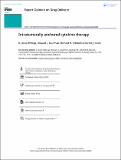Intratumorally anchored cytokine therapy
Author(s)
Wittrup, K Dane; Kaufman, Howard L; Schmidt, Michael M; Irvine, Darrell J
DownloadPublished version (1.007Mb)
Publisher with Creative Commons License
Publisher with Creative Commons License
Creative Commons Attribution
Terms of use
Metadata
Show full item recordAbstract
INTRODUCTION: On-target, off-tumor toxicity severely limits systemic dosing of cytokines and agonist antibodies for cancer. Intratumoral administration is increasingly being explored to mitigate this problem. Full exploitation of this mode of administration must include a mechanism for sustained retention of the drug; otherwise, rapid diffusion out of the tumor eliminates any advantage.
AREAS COVERED: We focus here on strategies for anchoring immune agonists in accessible formats. Such anchoring may utilize extracellular matrix components, cell surface receptor targets, or exogenously administered particulate materials. Promising alternative strategies not reviewed here include slow release from the interior of a material depot, expression following local transfection, and conditional proteolytic activation of masked molecules.
EXPERT OPINION: An effective mechanism for tissue retention is a critical component of intratumorally anchored cytokine therapy, as leakage leads to decreased tumor drug exposure and increased systemic toxicity. Matching variable drug release kinetics with receptor-mediated cellular uptake is an intrinsic requirement for the alternative strategies mentioned above. Bioavailability of an anchored form of the administered drug is key to obviating this balancing act.
Date issued
2022-06-02Department
Koch Institute for Integrative Cancer Research at MIT; Massachusetts Institute of Technology. Department of Chemical Engineering; Massachusetts Institute of Technology. Department of Biological EngineeringJournal
Expert Opinion on Drug Delivery
Publisher
Taylor & Francis
Citation
Wittrup, K. D., Kaufman, H. L., Schmidt, M. M., & Irvine, D. J. (2022). Intratumorally anchored cytokine therapy. Expert Opinion on Drug Delivery, 19(6), 725–732.
Version: Final published version